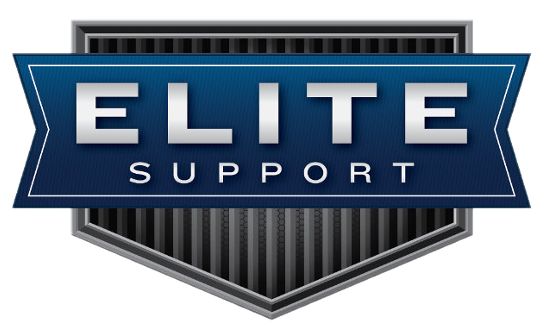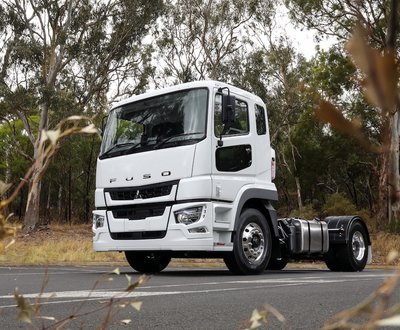The aerodynamic engineers have been busy ironing out the imperfections and improving air flow with subtle changes to the shape.
The truck’s new look is aided by the use of a sharp blue paint job, a change from the usual white Japanese prime mover. This look is a vast improvement on the red and black camo look used on the first evaluation truck in 2019.
Looking around inside the cabin, the layout is very familiar. Fuso has always gone with a flat set of lockers and pockets across the top of the engine cover. There are places to put odds and ends and others to store more substantial items. There’s a tray which fits a work diary and another where pens, phones, etc. can live. The provision of round drink holders seems to be lacking, but there are some square ones which should fit the bill.
The entertainment system is clearly ‘last generation’ following behind those offered in the latest trucks elsewhere in the Daimler stable. The information screen directly in front of the driver is relatively small, but reassuringly comprehensive. This is the window into the inner workings of the substantial computing, which comes to the fore in our first impressions riding Shogun. A short test drive just isn’t long enough to investigate its options fully.
On the road, steering is positive and, from the point of view of the driver, this truck has a firm ride, something common across the spectrum of Japanese heavy trucks, when compared to the long-distance highway prime movers with a European background.
This firmness can be somewhat overcome by increasing the softness setting on the air suspended seat. The driver deals with the firmer feel by adjusting the seat to take out the worst of the bumps. This adjustment is not too responsive and the driver ends up with the choice of quite firm or quite soft, with not much in between.
The items that any driver will notice in the new truck, which make their life easier, are those aspects imported from the Benz product. There is a very modern steering wheel with all of the control buttons close to the driver’s thumbs.
The layout is now common across Daimler. The entertainment system and phone controls sit on the left, while the right has the cruise control suite’s buttons. This is becoming a layout in most new trucks coming into this part of the market.
New trucks are almost all being offered with close to the full suite of bells and whistles, ABS and EBS of course, but also Advanced Emergency Braking (AEBS) and Adaptive Cruise Control (ACC). There’s also Active Attention Assist with the system monitoring driver input on the wheel or pedals to look for any fatigue-like symptoms. There is Electronic Stability Program (ESP) as standard and Lane Departure Warning System (LDWS) as well.
Of course, in a test situation like this, it is difficult to gauge the effect of these technologies’ inclusion, but as these systems become more commonplace and, increasingly, fitted as standard, the industry will become even more familiar with them. The point at which there is no need to mention their inclusion may be closer than we think. It is not necessary to include the fact the braking system uses full air, dual circuit with Fuso taper rollers. Perhaps the inclusion of AEB, ESP and LDWS will also not need to be remarked upon in the not too distant future.
In fact, this is a typical Japanese heavy. The difference, this time around, are all of those aspects of design and build introduced from the Daimler Group. The same could be said of those trucks built in Japan from the Volvo world, and the other two main Japanese truck makers are going through the process of introducing these more ‘European’ aspects of truck design, especially at the heavier end of the market.
With the introduction of these different influences in truck design, we are heading to a position where the technology in trucks is converging. The distinction between a US, European and Japanese truck in terms of the systems on offer is becoming less and less visible. Truck design is becoming more homogeneous and the global differences less distinct.
The trick here is not the technologies themselves, but the way they are put together, the way they are integrated into the overall truck system. As most of these modern heavy trucks come with a lot of the available bells and whistles, it is often in the driver interface where the cultural differences between Japan, Europe and the US can be found.
The way these systems connect with the driver tend to be least sophisticated in the Japanese product. This is understandable since the way trucks are designed and built for their domestic market is as a commodity and a functional tool in a business.
This is precisely how this new Shogun appears: As a useful functional tool in a business and not as a truck which is going to get any prospective driver excited about spending their working life behind the wheel.
At the end of the day, going on Diesel’s first impressions riding Shogun, the Fuso designers have brought all of the goodies the latest electronics and safety technologies can bring to a truck, without losing the typical solid feel of a heavy duty Japanese truck. A utilitarian truck has been developed to include all that the modern truck designer wants to add to the mix.




